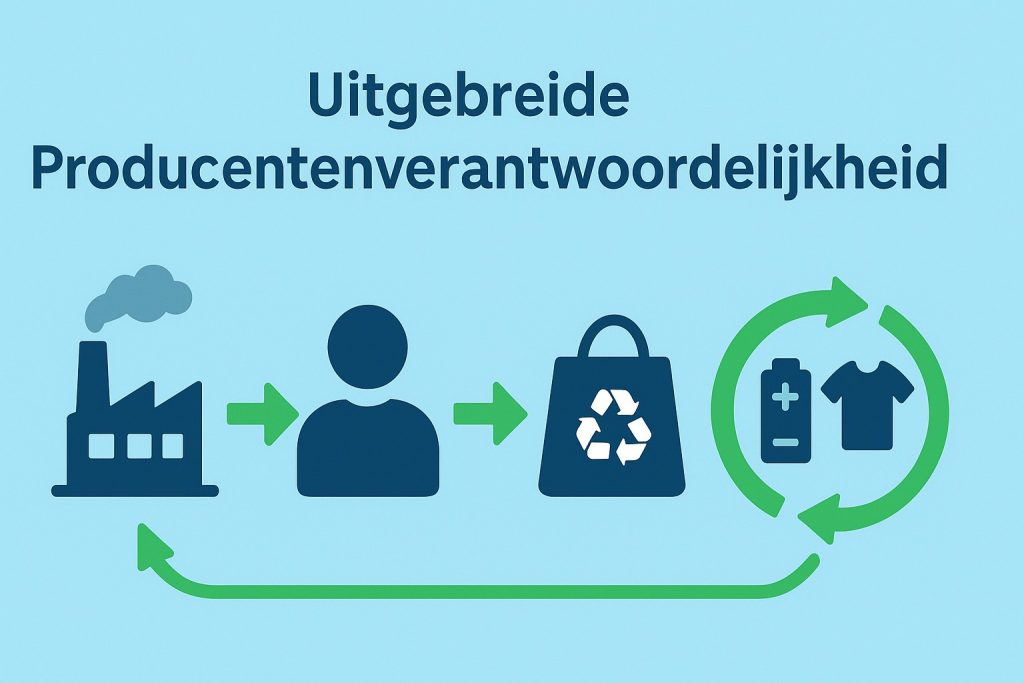Extended Producer Responsibility (UPV) imposes operational and financial responsibility on producers and importers for what happens to their products at end-of-life. With this article, we’ll help you determine if your organization is covered by UPV and how to comply.

The essence of UPV
Suppose you sell sportswear in the Netherlands. Then, according to UPV, you are responsible for what happens to that clothing when consumers throw it away. That means: making sure it is collected, recycled or reused. That’s UPV in a nutshell.
Extended producer responsibility thus encourages manufacturers and importers to design products that are more sustainable and recyclable. Making them financially responsible for collection and disposal creates an incentive to design smarter.
In the Netherlands, UPV applies to packaging, electrical equipment, batteries, tires, mattresses and textiles. The Environmental and Transport Inspectorate (ILT) and the Department of Waterways and Public Works (Rijkswaterstaat) supervise.
If you bring products onto the Dutch market within such a product group, you have four main obligations under UPV: registration with a producer organization or directly with Rijkswaterstaat, drawing up (and implementing) an awareness-raising plan for your customers, annual reporting on volumes and participation in a collection and processing system. In practice, the latter often means paying afterwards for the products (by weight) you put on the Dutch market. .
As an organization, are you UPV liable?
The party that is the first to market a product in the Netherlands is subject to UPV. This applies to both producers and importers. Do you work through a Dutch BV or subsidiary? Then the responsibility may rest with you.
Check if your products fall under a UPV category. For textiles, producers are formally responsible as of July 1, 2023, with active enforcement as of 2025. Some schemes have thresholds based on weight or market volume. For
How do you tackle it? Five concrete steps
There are two main routes: working through a producer organization (PRO) or setting up their own system. Most companies choose a PRO because they already have collection networks and administrative systems in place.
1. Map your products.
Inventory which products fall under which UPV category. This requires SKU-level analysis, including material composition and annual volumes. The
2. Register with the Department of Public Works
Producers and importers must register and report annually to Rijkswaterstaat. For textiles, for example, report by August 1 for the previous year. Practical information about registration can be found at Business.gov.nl. You can report individually or arrange this through a PRO. Incidentally, there are also producer organizations such as Verpact that can arrange this for you.
3. Choose between PRO or proprietary system
Producer organizations such as the UPV Textile Foundation arrange collection, processing and meeting legal targets. This is the most efficient route for most companies. An in-house system is realistic only for large players with substantial logistics capacity. This requires permits, contracts with processors and robust administration, but gives full control and opportunities to deploy UPV strategically within your circular ambitions.
4. Meet targets
For textiles, at least 50% of the volumes sold (by weight) must be prepared for reuse or recycling by 2025. This rises to 75% by 2030. Other product groups have their own percentages. So make sure partners and processors meet all reporting requirements so you can demonstrate that you are meeting these targets.
5. Establish administrative processes.
Expand your ERP system to include recording of quantities, weights and material composition. Collection rates, processing reports and costs must also be accurately tracked. The
Costs and risks
UPV involves several cost items: charges to a PRO (per kilogram or product), logistics investments in the case of a proprietary system, administrative burdens and possibly investments in product redesign. The latter reduce future UPV costs.
Failure to report or misreporting can result in fines proportional to global turnover. This makes calculating risk-taking not an option. Non-compliance also leads to reputational damage and exclusion from tenders. Recent
UPV in your ESG reporting
For CSRD-mandated organizations, UPV is not an isolated issue. It touches
UPV involves structural costs. These costs belong in your financial scenarios and
Are you developing circular products or working on materials reduction? Then it pays to factor UPV commitments into product design and procurement policies. Better recyclable materials reduce future charges. But be realistic: For most organizations, UPV remains primarily a compliance task.
Meeting UPV obligations requires clear processes. Employees in procurement, product development and finance need to understand what UPV means for their work. Because just filling out forms is not going to get us there.
Practical checklist for large organizations:
- Quick scan (0-4 weeks): which products fall under which UPV?
- Data readiness (4-8 weeks): availability of weight and volume figures
- Choice compliance model (4-12 weeks): PRO or proprietary system
- Contracts (8-16 weeks): enter into contracts with PROs or processors
- CSRD integration (ongoing): add UPV activities to reporting
In conclusion
UPV is a new reality for many organizations that requires clear processes and proper record keeping. For companies, it is essential to take on these obligations in a timely manner and integrate them properly into existing reports. Therefore, don’t start too late, because deadlines are coming sooner than you think.
